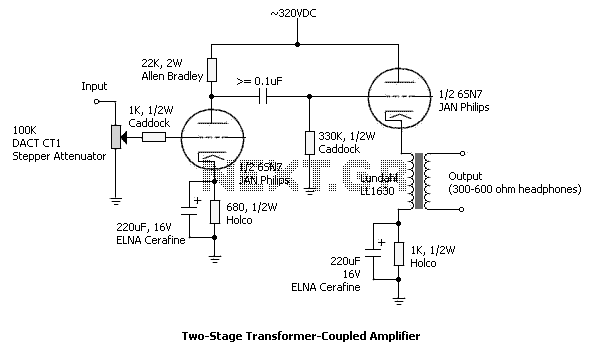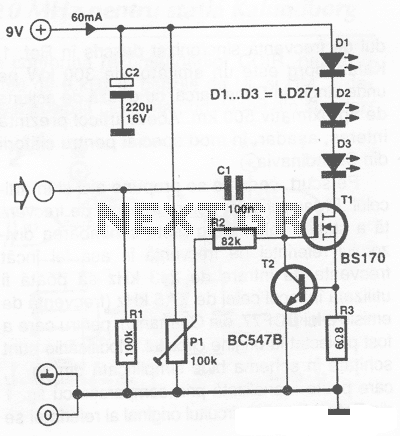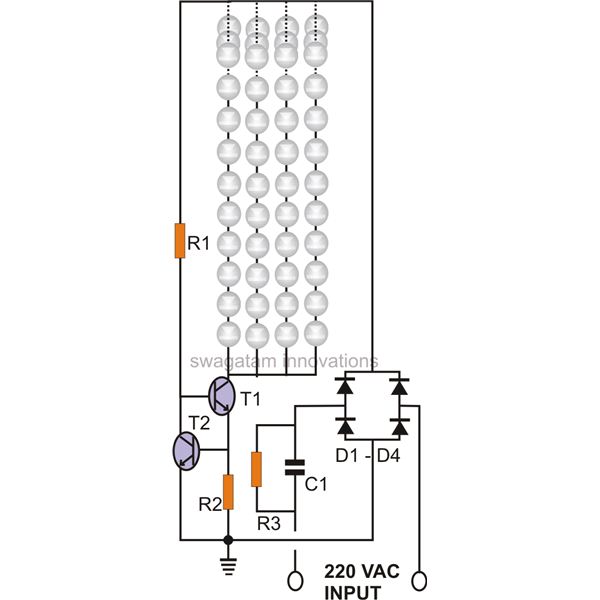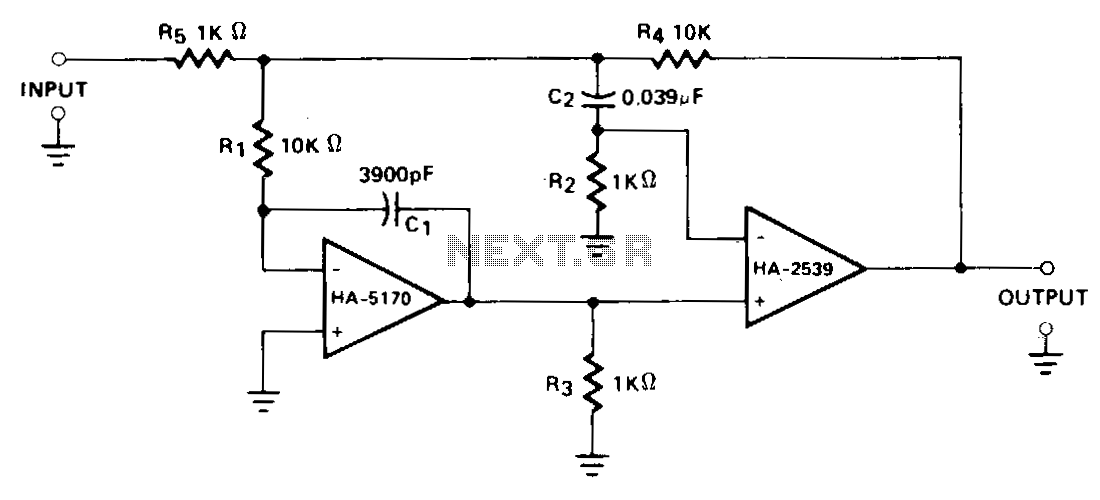
Tube Headphone Amplifier E182CC

To design a Tube Headphone Amplifier we need a triode with uncommon characteristics: enough voltage gain, low internal resistance and good anodic current. My first test was done with the E182CC, but there is the limitation on the usable impedance of headphones in the range of 300 to 600 ohms for maximum performance. The output impedance of the amplifier is about 35 ohms, and I don't accept any damping factor less than 8. The tubes that could be used are E182CC or 5687, but with the 5687, the gain is less. The E182CC is auto-biased to ground through the attenuator. It needs the 1K input resistor for stability, probably because there is no shield on middle of the tube. The LL1630 output transformer has a wide frequency response from 10Hz to 40kHz (+/-0.5dB), and a good inductance value to build a perfect headphone amplifier to drive headphones with impedance from 150 to 600 ohms. The LL1630 transformer here is used with parallel connection of the primaries. It must be gapped for a 10mA DC current, so that in parallel connection, it will run fine with the 20mA or less bias current of the output tube. When ordering this component from Lundahl, ask for LL1630/10mA. About the power supply, I suggest this Reference Power Supply that gives the best result, but is not very cheap to implement. The 100 ohm resistors across the filament supply are center grounded for low noise. The rectification comes from a Hybrid Graetz Bridge made with 1N5408 diodes and a RCA 5R4 rectifier tube. Although it has semiconductors, the sound depends on the rectifier tube, and the switching characteristic is that of the lower speed device - the tube. The hybrid tube bridge has the advantage that it can be driven from a single transformer secondary (the tube rectifier normally needs a dual secondary transformer). The other components are not cheap, and here the highest quality parts must be used to get the maximum result. About passive components types, I don't leave many choices: Holco or Caddock resistances on cathode, ELNA Cerafine or Blackgate capacitors on cathode and power supply, and the DACT stepper attenuator. NOBLE or ALPS normal attenuators don't give the same pure sound.
To design a high-performance Tube Headphone Amplifier, the selection of components is crucial. The E182CC triode is recommended due to its unique characteristics, which include sufficient voltage gain, low internal resistance, and a suitable anodic current. This triode operates optimally with headphones having an impedance range of 300 to 600 ohms, ensuring maximum performance. The output impedance of approximately 35 ohms necessitates a damping factor of at least 8 to maintain audio fidelity. The E182CC is preferred over the 5687 tube, as the latter provides lower gain, making it less suitable for this application.
For stability, the circuit incorporates a 1K input resistor, which is essential due to the absence of shielding in the midpoint of the tube. The LL1630 output transformer is an integral part of the design, offering a wide frequency response from 10Hz to 40kHz with minimal deviation (+/-0.5dB). This transformer is particularly effective for driving headphones with impedances ranging from 150 to 600 ohms. In this configuration, the LL1630 is utilized with the primaries connected in parallel, requiring a gap for a 10mA DC current to ensure compatibility with the output tube's bias current of 20mA or less.
The power supply design is equally important and should utilize a high-quality Reference Power Supply for optimal performance. This power supply design includes 100-ohm resistors that are center-grounded across the filament supply to minimize noise. A Hybrid Graetz Bridge rectifier, constructed with 1N5408 diodes and a RCA 5R4 rectifier tube, is employed. This configuration allows for the advantages of tube rectification while using semiconductors, providing a unique sound characteristic attributed to the slower response time of the tube.
To achieve the best audio quality, premium components are recommended throughout the design. For passive components, Holco or Caddock resistors should be utilized in the cathode, while ELNA Cerafine or Blackgate capacitors are advised for both the cathode and power supply. The DACT stepper attenuator is suggested for volume control, as alternatives such as NOBLE or ALPS attenuators do not deliver the same level of sound purity. This careful selection of components and design considerations will result in a high-quality Tube Headphone Amplifier capable of delivering superior audio performance.To design a Tube Headphone Amplifier we need a triode with uncommon characteristics: enough voltage gain, low internal resistance and good anodic current. My first test was done with the E182CC (figure 1), but there is the limitation on the usable impedance of headphones in the range of 300 to 600 ohms for maximum performance.
The output impedance of the amplifier is about 35 ohms, and I don't accept any damping factor less than 8. (About damping factor: for some, a damping factor of 4 or less is acceptable, but only because they have not heard a better tube headphone amplifier like this one.) The tubes that could be used are E182CC or 5687, but with the 5687, the gain is less.
The E182CC is auto-biased to ground through the attenuator. It needs the 1K input resistor for stability, probably because there is no shield on middle of the tube. The LL1630 output transformer (also used in my Tube Headphone Amplifier with Digital Input) has a wide frequency response from 10Hz to 40kHz (+/-0.5dB), and a good inductance value to build a perfect headphone amplifier to drive headphones with impedance from 150 to 600 ohms. The LL1630 transformer here is used with parallel connection of the primaries. It must be gapped for a 10mA DC current, so that in parallel connection, it will run fine with the 20mA or less bias current of the output tube.
When ordering this component from Lundahl, ask for LL1630/10mA. About the power supply, I suggest this Reference Power Supply (figure 4) that gives the best result, but is not very cheap to implement. The 100 ohm resistors across the filament supply are center grounded for low noise. The rectification comes from a Hybrid Graetz Bridge (from a Fulvio Chiappetta article in the italian magazine "Construire HiFi") made with 1N5408 diodes and a RCA 5R4 rectifier tube.
Although it has semiconductors, the sound depends on the rectifier tube, and the switching characterictic is that of the lower speed device - the tube. The hybrid tube bridge has the advantage that it can be driven from a single transformer secondary (the tube rectifier normally needs a dual secondary transformer).
The other components are not cheap, and here the highest quality parts must be used to get the maximum result. About passive components types, I don't leave many choices: Holco or Caddock resistances on cathode, ELNA Cerafine or Blackgate capacitors on cathode and power supply, and the DACT stepper attenuator.
NOBLE or ALPS normal attenuators don't give the same pure sound. 🔗 External reference
To design a high-performance Tube Headphone Amplifier, the selection of components is crucial. The E182CC triode is recommended due to its unique characteristics, which include sufficient voltage gain, low internal resistance, and a suitable anodic current. This triode operates optimally with headphones having an impedance range of 300 to 600 ohms, ensuring maximum performance. The output impedance of approximately 35 ohms necessitates a damping factor of at least 8 to maintain audio fidelity. The E182CC is preferred over the 5687 tube, as the latter provides lower gain, making it less suitable for this application.
For stability, the circuit incorporates a 1K input resistor, which is essential due to the absence of shielding in the midpoint of the tube. The LL1630 output transformer is an integral part of the design, offering a wide frequency response from 10Hz to 40kHz with minimal deviation (+/-0.5dB). This transformer is particularly effective for driving headphones with impedances ranging from 150 to 600 ohms. In this configuration, the LL1630 is utilized with the primaries connected in parallel, requiring a gap for a 10mA DC current to ensure compatibility with the output tube's bias current of 20mA or less.
The power supply design is equally important and should utilize a high-quality Reference Power Supply for optimal performance. This power supply design includes 100-ohm resistors that are center-grounded across the filament supply to minimize noise. A Hybrid Graetz Bridge rectifier, constructed with 1N5408 diodes and a RCA 5R4 rectifier tube, is employed. This configuration allows for the advantages of tube rectification while using semiconductors, providing a unique sound characteristic attributed to the slower response time of the tube.
To achieve the best audio quality, premium components are recommended throughout the design. For passive components, Holco or Caddock resistors should be utilized in the cathode, while ELNA Cerafine or Blackgate capacitors are advised for both the cathode and power supply. The DACT stepper attenuator is suggested for volume control, as alternatives such as NOBLE or ALPS attenuators do not deliver the same level of sound purity. This careful selection of components and design considerations will result in a high-quality Tube Headphone Amplifier capable of delivering superior audio performance.To design a Tube Headphone Amplifier we need a triode with uncommon characteristics: enough voltage gain, low internal resistance and good anodic current. My first test was done with the E182CC (figure 1), but there is the limitation on the usable impedance of headphones in the range of 300 to 600 ohms for maximum performance.
The output impedance of the amplifier is about 35 ohms, and I don't accept any damping factor less than 8. (About damping factor: for some, a damping factor of 4 or less is acceptable, but only because they have not heard a better tube headphone amplifier like this one.) The tubes that could be used are E182CC or 5687, but with the 5687, the gain is less.
The E182CC is auto-biased to ground through the attenuator. It needs the 1K input resistor for stability, probably because there is no shield on middle of the tube. The LL1630 output transformer (also used in my Tube Headphone Amplifier with Digital Input) has a wide frequency response from 10Hz to 40kHz (+/-0.5dB), and a good inductance value to build a perfect headphone amplifier to drive headphones with impedance from 150 to 600 ohms. The LL1630 transformer here is used with parallel connection of the primaries. It must be gapped for a 10mA DC current, so that in parallel connection, it will run fine with the 20mA or less bias current of the output tube.
When ordering this component from Lundahl, ask for LL1630/10mA. About the power supply, I suggest this Reference Power Supply (figure 4) that gives the best result, but is not very cheap to implement. The 100 ohm resistors across the filament supply are center grounded for low noise. The rectification comes from a Hybrid Graetz Bridge (from a Fulvio Chiappetta article in the italian magazine "Construire HiFi") made with 1N5408 diodes and a RCA 5R4 rectifier tube.
Although it has semiconductors, the sound depends on the rectifier tube, and the switching characterictic is that of the lower speed device - the tube. The hybrid tube bridge has the advantage that it can be driven from a single transformer secondary (the tube rectifier normally needs a dual secondary transformer).
The other components are not cheap, and here the highest quality parts must be used to get the maximum result. About passive components types, I don't leave many choices: Holco or Caddock resistances on cathode, ELNA Cerafine or Blackgate capacitors on cathode and power supply, and the DACT stepper attenuator.
NOBLE or ALPS normal attenuators don't give the same pure sound. 🔗 External reference





